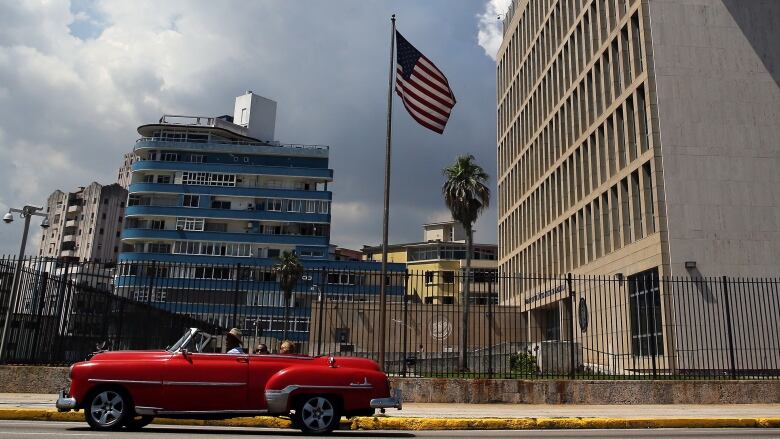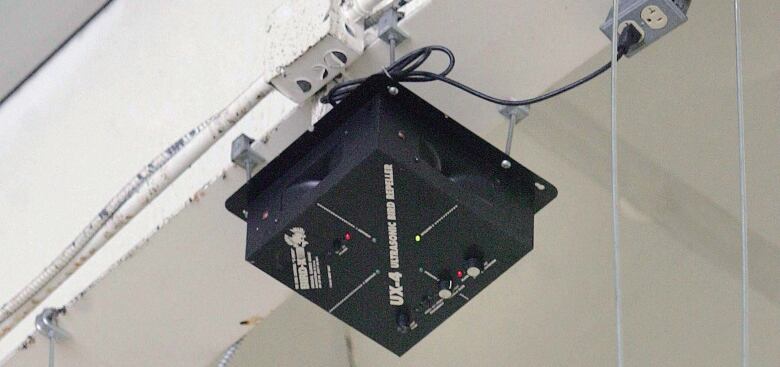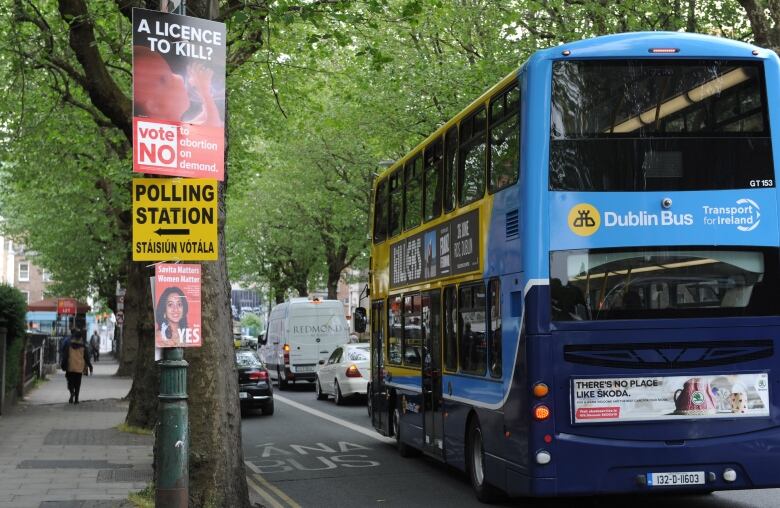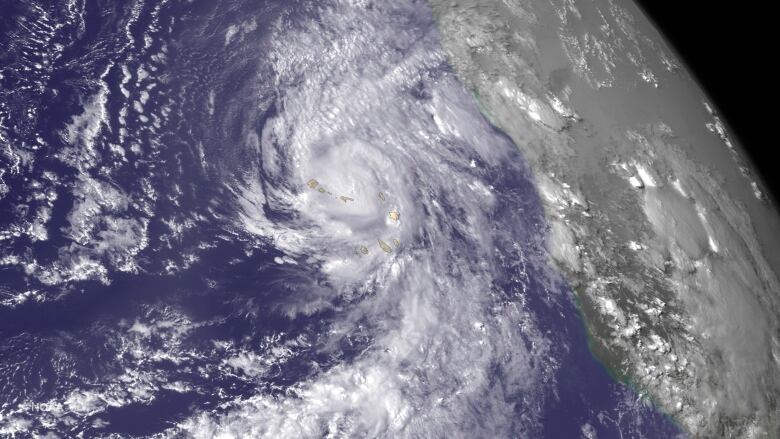Mysterious brain injuries at embassies may be linked to common ultrasonic devices
Newsletter: A closer look at the day's notable stories

Welcome toTheNational Today newsletter, which takes a closer look at what's happening around some of the day's most notable stories. Sign up hereand it will be delivered directly to your inbox Monday to Friday.
TODAY:
- Brain injuries suffered by embassy workers in China and Cuba may have been caused by phenomenon linked to everyday ultrasonic devices, researchers suggest
- Irish voters head to the polls to decide whether to repeal a constitutional amendment that has effectively banned abortions in the country since 1983
- The early forecast for the Atlantic hurricane season is windy, with plenty of destruction
- Missed The National last night? Watch it here
The sound and the worry
The U.S. government is warning its employees in China to be wary of "unusual sounds" that might be causing brain injuries.
It's an echo of the problems in Havana, Cuba, that sickened 24 American diplomats and their families, as well as 10 people at Canada's embassy. A staffer at the U.S. consulate in Guangzhou was recently diagnosed with a mild traumatic brain injury a.k.a. concussion after experiencing a "variety of physical symptoms" between late 2017 and early April.
A health alert issued by the American embassy in Beijing yesterday said the unnamed employee reported "subtle and vague, but abnormal, sensations of sound and pressure," prior to falling ill.
In an appearance before the U.S. Congress, Mike Pompeo, the new Secretary of State, said medical personnel have been sent to the consulate to investigate the new case, which he likened to the ongoing situation in Cuba.

The American and Canadian diplomats and their families in Havana reported a variety of concussion-like symptoms, including dizziness, headaches, nausea, nosebleeds and cognitive impairment yet none had experienced a physical blow to the head.
Initially, there were suspicions that the Cubans might be deploying some new type of sonic weapon, based on reports that some of the affected Americans heard painful, high-pitched noises.
Last October, the Associated Press released a six-second sound clip that was apparently recorded by a U.S. diplomat a grating, electronic screech that sets teeth on edge.
Months of investigations have failed to determine the cause of the illnesses at least as far as the public has been told.

Some experts, however, believe they know the source of the noises and the sickness, and that it's far from sinister.
"To call it an attack is to rule out a more likely explanation that it was an accidental exposure," says Timothy Leighton, a professor of ultrasonics and underwater acoustics at the University of Southampton in the U.K. "This peculiar recipe of symptoms has been anecdotally reported for years. They just haven't been taken seriously."
In 2016, Leighton published a paper in the Royal Society journal Proceedings A theorizing that waves from a whole host of ultrasonic devices from automatic doors to public address systems and even pest repellers might be quietly making people ill by disturbing balance sensors in the ear and confusing the brain.

For his 2016 study, the professor recorded the background noise in a number of public locations where people had previously complained about odd sensations and illnesses, including a train station, library and museum. In all cases he found high levels of ultrasonic noise.
Leighton is currently at work on another paper that demonstrates what he calls a "marginal link" between concussion-like symptoms in humans and exposure to very low levels of ultrasound. (Ethical guidelines prohibit scientists from exposing people to more powerful blasts and perhaps more severe symptoms.) It will be published in a special issue of the Journal of the Acoustical Society of America devoted to the topic of ultrasound in air.
The idea of someone attacking an embassy with an ultrasound weapon is far-fetched, he says, because such sound waves rapidly degrade over distance. High-frequency noises powerful enough to provoke symptoms would have to therefore come from somewhere inside the embassy most likely in the same room.

Kevin Fu, a computer scientist at the University of Michigan who works with ultrasound, analyzed the U.S. diplomat's six-second audio clip, and decided to try and figure out its source. One of his grad students, Chen Yan, devised a series of simulations that suggest the noise may have been caused by intermodal distortion which, according to this science blog post, "occurs when two signals having different frequencies combine to produce synthetic signals at the difference, sum, or multiples of the original frequencies."
In one experiment, Yan set up two speakers playing ultrasonic noise at different frequencies and managed to recreate the ear-shredding screech reported by embassy workers.
The problems in the embassies and consulate may therefore be as simple as a burglar alarm sensor or a high-tech anti-bugging system, crossing over with a plug-in mouse buster.
Ireland referendum
Irish voters head to the polls tomorrow to decide whether or not to repeal a constitutional amendment that has effectively banned abortions in the country since 1983.
The latest opinion surveys suggest that the "Yes" to a repeal campaign is headed for victory.
And a major factor may be the thousands of members of the modern Irish Diaspora making the trip home to cast their votes.

Flying #hometovote from London City now and Ive never seen so many women on the usually 90%male flight. Even a couple of @repealproject jumpers. Lets get this thing repealed! #Together4Yes #RepealThe8th
—@edelkirleyI'm coming #HomeToVote ! Will be traveling 5,169 miles from LA to Dublin and will be thinking of every Irish woman who has had to travel to access healthcare that should be available in their own country. Let's do this, Ireland! #repealthe8th #VoteYes pic.twitter.com/fZDxUIGrs9
—@LaurynCannyOn my way #hometovote, only 15 hours to get there and 2 days at home but worth it for #togetherforyes pic.twitter.com/8O7dt1HVFp
—@cornflakegirlieEstimates of just how many Irish citizens have emigrated abroad vary. The 2013 United Nations report on migration suggested that close to 770,000 Irish-born people are scattered across 72 other countries.
The Republic's department of Foreign Affairs and Trade puts the number at 1.47 million.

Earlier this week, the National Youth Council of Ireland estimated that there has been a 90 per cent increase in the number of young voters signing up for this vote, compared to the 2015 referendum that legalized same-sex marriage. It says as many as 125,000 have been added to the rolls.
The polls close at 10 p.m. (5 p.m. eastern in Canada) tomorrow, with results expected in the early hours of Saturday morning, Irish time.
- Like this newsletter?Sign upand have it delivered by email.
- You may also like our early-morning newsletter, the Morning Briefstart the day with the news you need in one quick and concise read.Sign up here.
Hurricane forecast
The early forecast for the Atlantic hurricane season is windy, with plenty of destruction.
Researchers at the U.S. National Oceanic and Atmospheric Administration released their annual outlook this morning, predicting a "near normal or above normal" number of storms.

The science is hardly exact, with this year'sprediction calling for:
- A 70 per cent likelihood of 10 to 16 named storms.
- Five to nine of those storms to graduate to hurricane status.
- Somewhere between one and four major (Category 3 or greater) weather events.
Another forecast, released last month by Colorado State University, predicted 14 named storms, seven hurricanes and three major systems. It also foresaw a heightened chance of a big-deal hurricane making landfall on the continental United States.
In comparison, last year saw 17 named storms, 10 hurricanes and six major ones packing winds in excess of 178 kilometres per hour. That's well behind the worst season on record 2005, with 15 hurricanes.

Research suggests that global warming is creating hurricanes with both more intense winds and greater amounts of precipitation, and that "100-year events" like the Harvey-induced floods in Texas are now occurring once every 16 years.
Records dating back to 1851 show that 10 of the 15 seasons with the most named storms have happened post-1999.
Quote of the moment
"If you change your mind having to do with this most important summit, please do not hesitate to call me or write."
- U.S. President Donald Trump leaves the door open in a letter to North Korean leader Kim Jong-un cancelling a planned June 12 summit meeting in Singapore.

A few words on ...
The NFL's crackdown on anthem protests. Sports Illustrated journalist RobertKlemko saysthis will likely encourage players some who didn't even take part in proteststo do so now.
What The National is reading
- Flight MH17 was brought down by a missile fired from Russia, investigators say (CBC)
- Zuckerberg set up fraudulent scheme to 'weaponize' data, court case alleges (Guardian)
- Exhaustion and relief on board first Hercules airlift for Manitoba fire evacuees (CBC)
- U.S. prepares to take action against Nicaragua if Ortega fails to cooperate (Miami Herald)
- World War II bomb explodes in Dresden (Deutsche Welle)
- Texas governor signals support for gun control measures after school shooting (Fox News)
- A new catcalling law in France would charge a 750 fine (Quartz)
Today in history
May 24,1966: Truman Capote on writing In Cold Blood
Truman Capote's take on the 1959 murder of the Clutter family in Holcomb, Kansas, and the subsequent arrest and trial of Perry Smith and Dick Hickock, was a groundbreaking nonfiction book. But he didn't like that people focused on the crime rather than his art. "The subject matter of my book was purely incidental," he tells Robert Patchell in this interview at his New York apartment. "It was the least interesting, or important thing, about the book."
Sign up hereand have The National Today newsletter delivered directly to your inbox Monday to Friday.
Please send your ideas, news tips, rants, and compliments tothenationaltoday@cbc.ca.













_(720p).jpg)


 OFFICIAL HD MUSIC VIDEO.jpg)
.jpg)



























































































